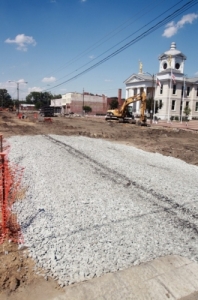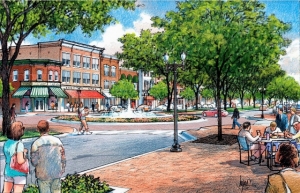Spinning downtown gold
By Ty Johnson
Published in News on June 10, 2012 1:50 AM

News-Argus/TY JOHNSON
A view of Center Street Friday from Mulberry Street looking northeast. The holly trees that have lined the street for decades were removed last week as part of the Center Street Streetscape project, which will replace them with larger, shade trees in an effort to revitalize downtown.

Submitted rendering
An artist rendering of a revitalized downtown looking northwest at the intersection of Walnut and Center streets showing large, shade trees on the median and widened sidewalks.
The holly trees are gone from Center Street.
They are due to be replaced by zelkovas and timber oaks by October when the Center Street Streetscape project is expected to conclude.
Those trees won't be saplings, but they certainly won't be full-grown either. Their trunks will measure about an inch-and-a-half in diameter and an errant weedwhacker could do some serious damage to their chances of survival.
Those who plant them will take the standard precautions: staking the trees with splints and ropes to help them grow straight and protective mesh to help them choke out weeds.
They will be cultivated and cared for until they grow enough to fend for themselves.
And that's just what the Streetscape project itself will need, Allison Platt says.
*
An urban designer, Ms. Platt has planned downtowns across the country, but Goldsboro caught her eye in a special way and, after submitting her master plan for the city center, she decided to make it her home.
Now she lives just blocks from where her vision is becoming reality as construction continues on the Center Street Streetscape. But the renderings she provided in 2007 weren't all brick and mortar.
Ms. Platt knows the true revitalization of downtown Goldsboro won't come solely from construction, but through public and private sector support and what Mayor Pro Tempore Chuck Allen has characterized as "a little love."
She points out that revitalization efforts in Salisbury and Greenville, S.C., might have started with public funds, but it was the resulting investment from corporations who brought jobs that needed to be filled by young people that truly got the ball rolling.
"CEOs think about those things," Ms. Platt said, referencing a business that moved its offices to Greenville, S.C., because the chief executive officer wanted to live downtown.
That's not something that can be gained through chain restaurants, she said, but comes only when there's something fresh and different about a town.
"It's nice to have Olive Garden coming, but that doesn't make a town authentic," she said.
Geoff Hulse, the chairman of the Downtown Goldsboro Development Corp. board of directors, echoed those sentiments.
"What makes your downtown unique are restaurants and nightspots and things you can't find anywhere else," he said.
Ms. Platt said an original, genuine downtown is the only way to ensure the city will thrive in the next decades.
"That's what's going to get smart young people here," she said.
And that's important for a city where Census data shows a continued aging of its population, she said. If parents and grandparents want their offspring to hang around to make Goldsboro a better place, the city needs to get its own personality.
"If you have an authentic downtown, then people will want to live here," she said. "If you don't have that, the city won't survive."
The Streetscape project, she hopes, will make that point clear, especially when the contrast comes into focus at the intersection of Mulberry and Center streets -- where old downtown ends and her vision turned reality begins.
Changing the public opinion likely won't do it all, though, she said, noting that there's a chance that investment could come on its own, but that a more hands-on approach would probably be needed.
Hulse also said the Streetscape, although a proven winner in other cities, was not going to be enough.
"It's worked everywhere it's gone," Hulse said of streetscapes in other towns. "If there were major failures, we would have heard about it. But we'll need continued leadership within the city and business community and the DGDC to try to get more businesses down here."
As far as making downtown a priority, it seems there's no lack of leadership at the head of the City Council where Mayor Al King has staunchly supported the city's downtown investments, even as criticism poured in from all sides.
When yet another tirade was launched at him for "wasting taxpayer money" on Center Street, he shot back, saying that if the investments the city was making into its future were a waste of taxpayer dollars, he intends to continue to waste much more in the years to come.
And more investment will likely be needed, Ms. Platt said.
"You can't just have an 'If you build it, they will come' attitude," she said. "You have to help it grow in the early years."
And so, just like the willow oaks that someday will dwarf Historic City Hall and offer shade to future Goldsboro residents, the city is going to need to offer some support and protection if downtown is to grow.
But how can a local government, already strapped for funds, invest in a financial climate where all of the grant pools have dried up and tax dollars are stretched thin to cover services?
*
Goldsboro isn't the only city whose revitalization Ms. Platt is presiding over these days.
Up in Danville, Va., she submitted a master plan last March just as she did in Goldsboro five years ago.
City officials there, however, have already begun their renovations in earnest, using an incentive known as gap financing, she said.
The concept involves the city covering the difference between the investment total and a development's initial revenue, allowing developers to take risks knowing that if it doesn't pan out immediately, they can be assured of breaking even.
"No one is going to want to take on a building where the revenue isn't going to cover the investment," Ms. Platt explained.
The Downtown Goldsboro Development Corp. began a program similar to that when it received the Main Street Solutions grant to assist with the move of the Arts Council of Wayne County to the corner of John and Walnut streets.
Half of the $200,000 grant was placed into a revolving loan coffer, from where Jeff and Cindy Darwin, the owners of the property the Arts Council bought, borrowed to renovate the building, including installing a new elevator.
The loan, if paid back soon enough, won't require any interest payments and will be used again and again for other downtown projects with similar low-interest options.
It's not quite gap financing, DGDC Director Julie Thompson said, but it does allow businesses the low-risk opportunities to improve.
Another financing option to help entice businesses and developers to shape up their properties are tax delays -- an idea that was kicked around at the Goldsboro City Council retreat but hasn't drawn much attention.
The concept is to tax renovated properties at their pre-renovation tax value for a few years, allowing businesses to recover from their investment before paying the taxes back after a period of time. The idea would need to be approved by the city and county, she explained.
It's shown to be effective in towns like Smithfield and Morganton and could be another way Goldsboro could provide business incentives without putting public funds on the line.
It's a symptom of the times, when federal and state grants are rare, and cities are left to fend for themselves. Gone are the days when, like Salisbury, Goldsboro could leverage local funds along with grants to buy properties.
But that doesn't mean downtown Goldsboro will be sitting still.
*
It's perhaps been dwarfed a bit by the Center Street Streetscape project on the north end of downtown's main hub, but the city's downtown master plan also calls for investment on the street's south end near Elm Street, where the city has purchased a handful of plots to be developed into single family dwellings.
Master plan renderings show homes lining the street's south end -- the product of a future public-private partnership that Ms. Thompson said the city should begin exploring later this year.
"We hope to, by the end of the summer, to begin to develop (a request for proposals letter) for developers for homes down there," she said.
That won't be all that's needed, she explained, but city officials knew more incentives would need to be put together to reap the kind of investment they were looking for when they purchased the properties.
It was the city's first step into flipping properties, but it followed with the DGDC office, and will likely lead to more of those types of investments, she said.
"I could definitely see us getting into more of that," Ms. Thompson said. "Each time we do it, we get a little bit better in moving toward our next step."
The city's most aggressive move in its downtown development then, it seems, has been with investments into downtown's surrounding neighborhoods, but that still doesn't quell concerns about the empty storefronts downtown.
Just as there seems to be a chicken and egg quandary among the public between private investment and public investment -- over which has to come first -- there also is one as to whether residential or commercial investments should come first.
Sitting on a dozen residential plots of land, the City Council seems to have decided it values business recruitment most, even suggesting the funding of a part-time business recruiter position using $8,000 it tried to squeeze out of DGDC's paltry municipal service district fund built from a special tax on downtown properties. The position was never funded, however.
Moving forward, Ms. Thompson said she sees the potential for more relationships with businesses, but said she doesn't envision employing an additional staff member to handle business recruiting.
"I'd like to see us working with businesses to strengthen their bottom line," she said, noting that the current staff and DGDC's economic restructuring committee could reach out more to businesses in that way. "I see us having more focus on it, but don't see it being a full-time focus."
That, she said, is because the properties downtown still need work, which can be helped along with programs DGDC already offers, like facade grants and rent assistance grants for businesses and developers.
She says Goldsboro is still in a position where the city needs to continue to "set the table" for business investment.
She hopes renderings that are in the works to show the potential of facade grants will inspire downtown property owners to invest in their properties. She said the last time renderings were prepared for downtown properties, there was a 100 percent rate of investment in those properties.
Following more of that type of investment, she sees the city getting more involved in bringing anchor projects to downtown.
"Once those things are in place, we'll start shifting," Ms. Thompson said of DGDC's focus.
A hitch was thrown into downtown's development when the City Council voted to put the recreation center on the back burner in April 2010. The center was to be one of downtown's main draws, but the bids were thrown out .
The Arts Council move in summer 2011, however, was a step in the right direction, Ms. Thompson said, and should serve as a reminder that her department still has its eyes on the prize.
"The economy has slowed us lately, but were still on the right track," she said.
And that track is one newly paved and shaded by willow oaks.
